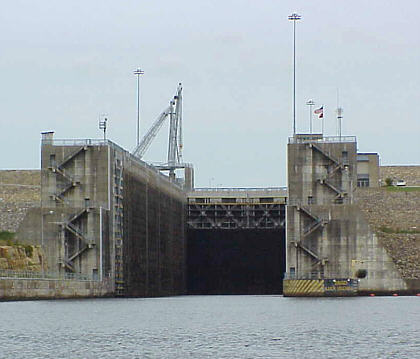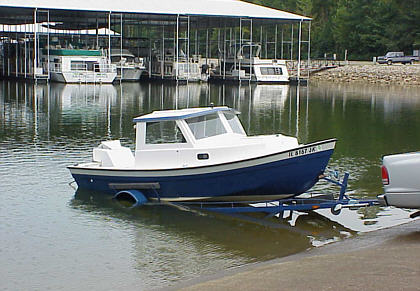|
Page 5
On the downstream trip we had encountered a fairly heavy buildup at Stennis but luckily a 40 ft trawler had exited heading north before we entered and opened a path. But now the buildup was heavier and I was on my own to push through. If there is nothing too large my usual approach is to take a little run at it, kill and trim up the outboard and try to glide through. I have found that trying to idle through usually ends with disappointment. When running long distance I usually have on one of my aluminum props as these have proven to out perform my stainless one. I know that not what the experts say but that is what I have found on Therapy. I believe part of the reason for this is in a quest for good performance Honda has made the aluminum blades VERY thin. They work well but are very susceptible to damage. If I catch a chunk of debris of any size it will bend a blade. And when trying to idle through drbris something invariably bangs along the hull bottom and finds the prop. Most of the time I can squeak through but as I quietly move forward I see about a 6” diameter tree limb about 15’ long sliding under the bow. Helplessly I watch as Therapy raises a little as it makes its way to the center of the hull and then hangs. Well, &#(%&^@….. I pull out my boat hook and try to move it around but it is going nowhere. I rock the hull while pulling and pushing and still nothing. The lockmaster sees that I am having a problem and swing a spotlight around and illuminates the area which gives me a better idea what I am up against.
I trim her down and fire up. Just a little throttle gets me nowhere so I have to lean on it fairly hard. Therapy finally starts to slide off it when I hear a WACK and know the prop has had a personal moment with a hunk of wood. To late to worry and I keep on the throttle. The log slides away and I ease her back into forward and steer to clear. WACK – I catch something again. Bruised but free I idle over to the anchorage. The lockmaster must feel sorry for me and uses his spotlight to guide me to the area. I drop anchor and call back on the radio and thank him for the assistance. He says, “No problem,” and turns off the light. I decide to trim up the engine and take a look. I find that I had one slightly bent blade and one very bent blade. I will say be cause of the number of times I have bent these I have become somewhat proficient at straighting them. Onboard I always carry a six inch piece of oak 2”x 4”, a 3 lb plastic dead blow hammer, a 3” square of 3/8” thick rubber mat and a 4” piece of #6 heavily insulated wire. It would be hard to explain how I use these but I can normally true up the damage well enough to make it functional. Not perfect but functional. But then again I have had lots of practice! I get a little more right then and spend the next 15 minutes pounding it straight.
I wake the next morning to a colorful sunrise (photo above). Remembering the old adage about “Red Sky in the Morning,” I know it is time to continue my quest northward. In fact, the rest of the trip is quite uneventful. The lockages go with out a hitch as almost all were waiting for me with miter gates open. As a result, I make excellent time and end this final 123 mile leg when I idle into Pickwick Marina about 2:30 pm, exactly five days after we started. I also had out run the rain that would roll into the area the next day. All up the entire trip had covered 1034 miles and logged 51 hours tach time. On the long drive home I had a chance to reflect on the highlights. Among them were my first experience with the Intracoastal Waterway, watching shrimp boats work, out running a hurricane AND being threatened with a machine gun. I also had somewhat of a personal milestone when near the 186 marker I logged mile 10,000 on Therapy. Kind of a special moment being an 18' watercraft.
Why wait? The rivers maybe timeless
but we are not. Pack the
cooler, fill the tanks, cast off the lines and make memories that will
last a lifetime. See you out there………
|
 I
did encounter some difficulty when exiting the chamber. In
the spring
of the year and after a high water situation it is not unusual for
floating
debris to gather on the upstream side of a lock. The amount
of current
and prevailing winds often contribute to some locks having more
problems
with this than others.
I
did encounter some difficulty when exiting the chamber. In
the spring
of the year and after a high water situation it is not unusual for
floating
debris to gather on the upstream side of a lock. The amount
of current
and prevailing winds often contribute to some locks having more
problems
with this than others.
 Doesn’t
look good. The small TREE is hung fairly solid. No
other choice
I am going to have to use the outboard to try to power of it.
The
problem is that by now all the junk I had push through has now closed
in
around me. I know it is going to take a good bit of reverse
throttle
to pull Therapy off the log which will suck all the junk at the transom
down into the prop. Oh Well – no other choice.
Doesn’t
look good. The small TREE is hung fairly solid. No
other choice
I am going to have to use the outboard to try to power of it.
The
problem is that by now all the junk I had push through has now closed
in
around me. I know it is going to take a good bit of reverse
throttle
to pull Therapy off the log which will suck all the junk at the transom
down into the prop. Oh Well – no other choice.
 At
home I have built a truing fixture that allows me to get it very close
to the needed 14 degrees of pitch. I will normally straighten
a prop
two or three times myself but then take it to a professional to make
sure
it is right. Interestingly, I have enough experience with
Therapy
that I can detect even a small bend in on a blade by monitoring the
combination
of the fuel flow meter, tach and digital speedo. I may not
have felt
the strike or note any vibration but it does show up in the performance.
At
home I have built a truing fixture that allows me to get it very close
to the needed 14 degrees of pitch. I will normally straighten
a prop
two or three times myself but then take it to a professional to make
sure
it is right. Interestingly, I have enough experience with
Therapy
that I can detect even a small bend in on a blade by monitoring the
combination
of the fuel flow meter, tach and digital speedo. I may not
have felt
the strike or note any vibration but it does show up in the performance.
 But
once again this little wooden boat proved can pass muster as a long
haul
voyager. It is not fancy or flush on creature comforts but a
solid
river runner that once again delivered me back home physically safe and
spiritually satisfied. It also serves to prove the point that
to
make long cruise on rivers and the Intracoastal Waterway you don’t have
to have a 30 or 40 ft boat and a big wad of money. Anyone
with dependable
watercraft and the desire (an understand wife helps too!) can duplicate
any of my trips. For me it has been well worth the effort and
if
you have taken the time to read this whole story I am betting you would
enjoy it too.
But
once again this little wooden boat proved can pass muster as a long
haul
voyager. It is not fancy or flush on creature comforts but a
solid
river runner that once again delivered me back home physically safe and
spiritually satisfied. It also serves to prove the point that
to
make long cruise on rivers and the Intracoastal Waterway you don’t have
to have a 30 or 40 ft boat and a big wad of money. Anyone
with dependable
watercraft and the desire (an understand wife helps too!) can duplicate
any of my trips. For me it has been well worth the effort and
if
you have taken the time to read this whole story I am betting you would
enjoy it too.